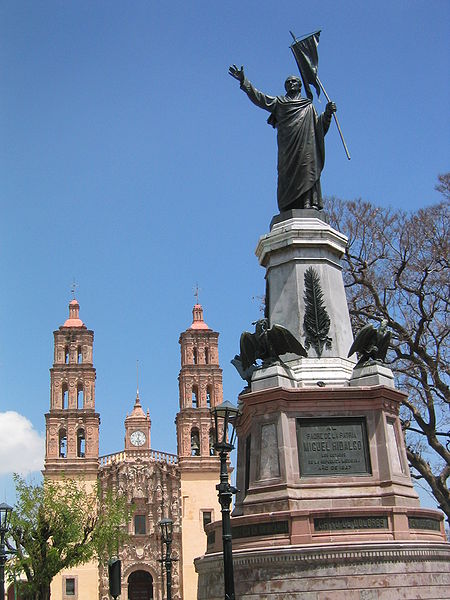September 11 - 17, 1810
Mexico Goes to War for Independence
September 2011

Statue of Miguel Hidalgo y Costilla in front of his church in Dolores Hidalgo, Guanajuato, Mexico. |
This week we turn to an historic event of extreme importance to revival of an alliance of sovereign nation-states in the Americas: the Sept. 15, 1810 uprising of the Mexican republican independence movement against Spain. A wealth of material is currently being unearthed by the LaRouche political movement, which demonstrates the coordination, from at least the 18th century forward, among the republican forces of the Americas, toward the establishment of a community of sovereign republics. This history has been suppressed, as was this original independence movement in Mexico and the rest of the Americas, by those oligarchical—today, Synarchist—forces who wish to bury the ideas of the American Revolution forever.
The instigator of the Sept. 15, 1810 revolution was a Mexican priest, Miguel Hidalgo y Costilla. Hidalgo had been working in the state of Guanajuato, where he had distinguished himself by promoting all kinds of industry and inventions, including the silkworm industry, the pottery industry, tanneries, and later, steel-casting and cannon construction. Hidalgo had also formed a Classical music orchestra made up largely of Indians.
Within days of Hidalgo's call for the faithful to rally for the liberty of New Spain (as Mexico was then called), he held a meeting with Jose Maria Morelos, a priest from the state of Michoacan, and a member of the so-called "low clergy"—i.e., of Indian or mestizo origin. The two then formed an alliance in pursuit of independence, and an alliance with the United States of America.
From the early days of their revolution, both Hidalgo and Morelos declared slavery and debts abolished, and called themselves "Americans." They were explicitly inspired by the American Revolution and its Constitutional project and, while seeking to defend Roman Catholicism against the Bonapartist takeover of the French Church, sought an alliance with, and assistance from, their northern neighbor.
The story of how such an alliance was sabotaged, is far beyond the scope of this column, but the story will soon be made available in publications of the LaRouche movement. The fact that this collaboration between English and Spanish-speaking republicanism in this Hemisphere represented, and still represents today, a potent threat to the oligarchy, is underscored by what happened to this first Mexican revolution.
Having suffered various military defeats, in March 1811, Hidalgo decided to march toward the United States, in search of military aid and support. He was captured by Spanish royalist forces, put on trial, and killed. The same fate was suffered four years later by Morelos, who had sent his son to study in the United States.
Before they were executed, both priests were "tried" by the Inquisition, which had been revived in this period for use against the republican movement. The charges against both were "heresy," the "evidence" of which included the fact that they had sought an alliance with the United States, and had adopted philosophical "toleration" of that nation.
This served as quite a warning to those republicans in all the emerging South American republics who sought to work with the North Americans, but the reactionaries did not leave it at that. In the period between 1811 and 1816, a bloodbath was undertaken against republican forces, including scientists, in both New Grenada (today's Venezuela, Colombia, and Ecuador) and New Spain (Mexico). General Pablo Morillo, who carried out the slaughter in New Grenada in 1816, echoed the British "Jacobin" slogan justifying his murder of 500 scientists: "The revolution doesn't need scientists."
As the real history of American republicanism is rescued from the hands of such "left" and "right" servants of oligarchism, it is appropriate that Sept. 15, 1810 become a day of celebration for us all.
The original article was published in the EIR Online’s Electronic Intelligence Weekly, as part of an ongoing series on history, with a special emphasis on American history. We are reprinting and updating these articles now to assist our readers in understanding of the American System of Economy.††
